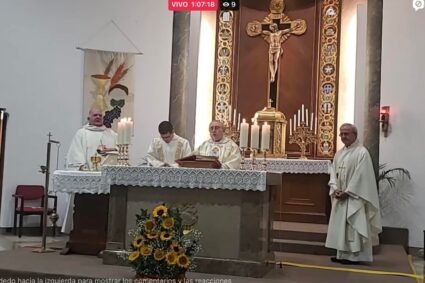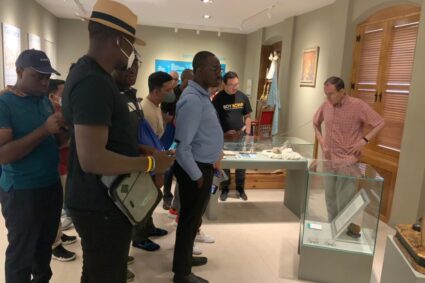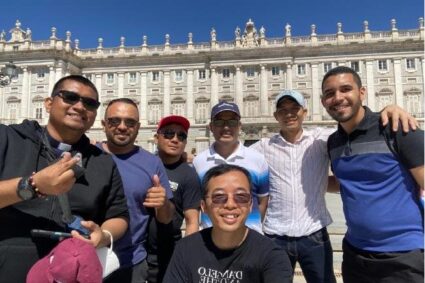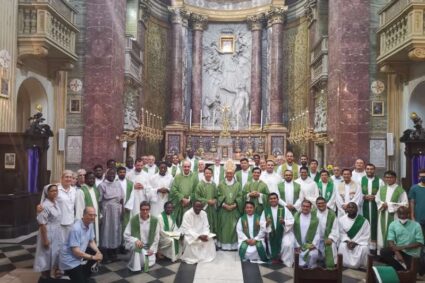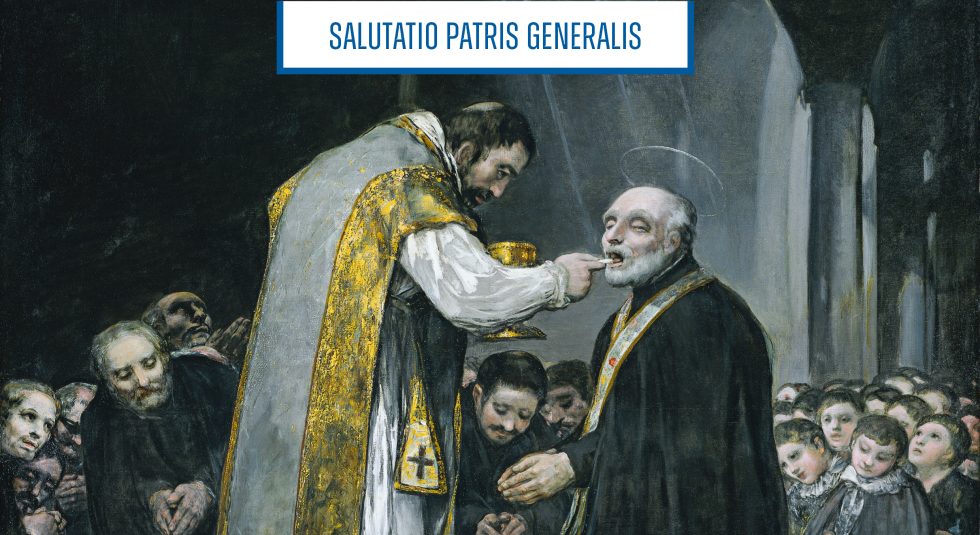
English / Castellano
This is the formulation chosen by our General Chapter to express the first of the Keys of Life of the Order, framed in the so-called nucleus that constitutes the “centrality of Jesus Christ in our life and mission“. Two options are proposed to us for the proper experience of this nucleus: spirituality and community life. I wrote about the latter last month; now I have decided to write to you about the former.
My intention is very simple: to offer you some simple comments on some of the proposals and criteria based on which our chapter document poses the challenge of going deeper into our Piarist spirituality. Let us go ahead.
I would like to begin by emphasizing that the “going deeper into our spirituality” is the first of the Keys of Life based on which our General Chapter defined the “configuring core” of the road that we are called to travel in this sexennium and, undoubtedly, far beyond the temporal limits within which a General Chapter illuminates the life and mission of the Order. I do not believe that this fact – its primacy – is insignificant. On the contrary, it carries with it a message and marks a path.
For this reason, it is good to begin by saying something that, although repeated, is no less important: Christian spirituality consists in living according to the Spirit, following in the footsteps of Jesus. This is the shortest and most concrete definition we can give of this exciting challenge. Spirituality is a way of following the Lord, which is expressed and lived in discipleship, as a vital dynamic that helps us to live from God and opens us to act in openness and listening to the Spirit.
The Calasanctian spirituality is rooted in the way in which our founder incarnated and assumed that way of following: to walk out of the deep desire and aspiration to be configured with Christ. The Piarist spirituality comes from that Calasanctian spirituality, enriched by the diverse responses and experiences that as an Order we have been giving throughout the centuries and by the discoveries that have been shaping what we are and what we are called to live, as expressed in our Constitutions.
We live in a world in which the loss of the sense of God and the narrowing of the horizons of humanity make it very difficult to understand and experience “the spiritual” for so many people, including those who live and grow among us. It is not superfluous for us to think whether, in spite of our identity and our consecration – those of us who are religious – or in spite of our choices of Christian and Piarist life, we have to rethink this exciting challenge. This is the objective of the Chapter.
I remember a paragraph from Karl Rahner’s well-known book “Structural Change in the Church”. The book is 50 years old. But it says things like this: “We need a Church of authentic spirituality. We run the risk of being, in the field of the spiritual, to a tremendous extent, a lifeless Church, in which ritualism, legalism, bureaucracy and a “getting by” with increasing resignation and tedium along the usual paths of spiritual mediocrity predominate.” [1] The experience and care of spirituality is a necessity of Life with capital letters. That is why I believe that our Chapter challenges us accurately when it calls us to “go more deeply” in this dimension. A superficial, neglected, or inconsistent experience of our spirituality exhausts and withers our treasure and prevents us from offering our students and youth what they need most.
Let us enter into the content of the document and the Lines of Action that it offers us. I think the whole text is very meaningful.
1-In the first place, eight criteria are proposed based on which we are called to raise our spirituality. We must read them carefully, because they indicate very specific paths, expressed in terms of an active and provocative language. We speak of cultivating, of walking, of living according to projects, of synodality, of sharing, of prophesying, of communion, of integral ecology.
In short, these are the calls we receive: to live spirituality as a path of holiness; cultivate our spirit of prayer; synodality and construction of communion and solidarity; projects and options that respond to what the Church and the world today need from us; to share our treasure with the Fraternity and with the people who walk with us; to assume the call to be prophets; to live from an integral ecology.
I believe that they are rich, current, and purposeful criteria, and express the desire – and the option – of the Order to listen to the feelings of the Church and, above all, of young people.
2-Secondly, the document presents us the central option of Calasanz, upon which our Holy Father configured and lived his spirituality: kenosis. The document refers to this centrally Calasanctian experience. It is enough to relate two well-known texts by Calasanz to understand it. “A good principle of the spiritual life is that of one’s self-knowledge and misery in which we are all born and also of the ingratitude with which, after so many benefits, we have responded to God.” [2]
Let us see the path he proposes to achieve this: “The shortest and easiest way to be exalted to one’s self-knowledge and from it to the attributes of God’s mercy, prudence and infinite patience and goodness is to lower oneself to give light to children, and in particular to those who are like the helpless of all, and since it is an office in the eyes of all so low and so vile that only a few want to lower themselves to it, and God usually gives one hundred for one, especially if doing it well, though amid persecutions or tribulations in which, if taken with patience from the hand of God, the power of spirit is found. ” [3]
I think it is very significant that the General Chapter reminds us that the underlying attitude with which we can deepen our spirituality is kenosis, the lowering of oneself, in imitation of the one Master.
3-Third, our document highlights some of the notes of our spirituality that are perhaps most needed in today’s world. This is a beautiful exercise in community discernment: What are the keys to our spirituality that are most necessary today and, therefore, most important for us to take care of and deepen? Why does the 48th General Chapter highlight these keys, each of them? They are these: Christ-centered spirituality, docile to the Spirit, attentive to the Word, service-provoking, communion-seeking, sacramental, Marian, ecclesial, prayerful, connected to the mission and incarnated in life, cultivating the Calasanctian pedagogical virtues, dynamic and supportive of the mission.
It would be a good community exercise to think about each of these characteristics and try to reflect, in common, on what the challenge of deepening each of these characteristics means for our life and our community. They are not theoretical, but rather provocative new responses.
4-Finally, the chapter document proposes some “Lines of Action”. I will comment only on the first three, although there is no doubt that the seven that are proposed have a remarkable power for renewal.
1.-To cultivate spiritual accompaniment. I think that the proposal to live spiritually accompanied (in a personal and community way) resonated strongly in the chapter hall. It is interesting to note the fruits that the Chapter says we can receive if we live in this way: “a better understanding of God’s will in our own lives and a better knowledge of ourselves.” There is no doubt that we are facing a “path of spiritual growth” that would be very important for our demarcational chapters to reflect upon and strengthen.
2-To work on processes that enrich our personal and community prayer. The Chapter affirms that we have to take care of and enrich our prayer, and that this means working on those processes that make it possible. I highlight a few: the learning of meditation, lectio divina, the care of the community Eucharistic celebration, the personal project of spiritual life, the attention to the devotions that help us the most, the community retreats, the dynamics of spiritual exercises, the spiritual direction, etc.
3-To enhance our spirituality from the encounter with children and young people, preferably poor. Our spirituality is strengthened from children and young people, as happened to Calasanz. Our founder offered children and young people an original and new way of understanding one of the greatest novelties of the Gospel proclamation, which is none other than the experience that God loves us. Calasanz offers children the experience of feeling loved by God. Sometimes we do not realize the depth and radicality of this deeply spiritual experience. The Piarist who distances himself from the children and young people loses contact with the source that assures his vitality. The “distancing” is also something spiritual. There can be Piarists who are all day in the mission with the children, but spiritually far away from them, and Piarists in other tasks not directly related to the frequent contact with children and young people, but deeply close to them and nourished by this inexhaustible spring of life that emerges from those for whom Calasanz founded the Pious Schools.
I would like to end this fraternal letter with a very concrete invitation: that in all our communities we dedicate some time to share the challenges that this first Key of Life of the Order proposes to us: the Piarist spirituality. I am sure that we will find new questions and new ways of following and fidelity.
Receive a fraternal embrace.
Pedro Aguado Sch.P.
Father General

Profundizar en nuestra espiritualidad escolapia
English / Castellano
Esta es la formulación elegida por nuestro Capítulo General para expresar la primera de las Claves de Vida de la Orden, encuadrada en el así llamado núcleo configurador de la “centralidad de Jesucristo en nuestra vida y misión”. Son dos las opciones que se nos proponen para la adecuad vivencia de este núcleo: la espiritualidad y la vida comunitaria. Sobre esta segunda escribí el pasado mes; ahora me he decidido a escribiros sobre la primera.
Mi pretensión es muy simple: ofreceros algunos comentarios sencillos sobre algunas de las propuestas y criterios desde los que nuestro documento capitular presenta el reto de profundizar en nuestra espiritualidad escolapia. Vamos allá.
Quiero comenzar destacando que la “profundización en nuestra espiritualidad” es la primera de las Claves de Vida desde las que nuestro Capítulo General definió el “núcleo configurador” del camino que estamos llamados a recorrer en este sexenio y, sin duda, mucho más allá de los límites temporales desde los que un Capítulo General ilumina la vida y la misión de la Orden. No creo que este hecho -la primacía- sea algo insignificante. Por el contrario, lleva consigo un mensaje y marca un camino.
Por eso es bueno empezar por decir algo que, no por repetido, deja de tener su importancia: la espiritualidad cristiana consiste en vivir según el Espíritu, siguiendo los pasos de Jesús. Esta es la definición más breve y concreta que podemos dar de este apasionante desafío. La espiritualidad es un camino de seguimiento del Señor, que se expresa y se vive en el discipulado, como una dinámica vital que nos ayuda a vivir desde Dios y nos abre a obrar en apertura y escucha del Espíritu.
La espiritualidad calasancia radica en el modo en el que nuestro fundador encarnó y asumió ese camino de seguimiento: caminar desde el profundo deseo y aspiración de configurarse con Cristo. La espiritualidad escolapia procede de esa espiritualidad de Calasanz, enriquecida con las diversas respuestas y experiencias que como Orden hemos ido dando a lo largo de los siglos y por los descubrimientos que han ido configurando lo que somos y estamos llamados a vivir, tal y como se expresa en nuestras Constituciones.
Vivimos en un mundo en el que la pérdida de sentido de Dios y el estrechamiento de los horizontes de la humanidad dificultan mucho la comprensión y la vivencia de “lo espiritual” en tantas personas, también entre aquellas que viven y crecen entre nosotros. No está de más que nosotros pensemos si, a pesar de nuestra identidad y de nuestra consagración -quienes somos religiosos- o a pesar de nuestras opciones de vida cristiana y escolapia, necesitamos replantarnos este apasionante reto. Este es el objetivo que nos plantea el Capítulo.
Recuerdo un párrafo del muy conocido libro de Karl Rahner “Cambio estructural en la Iglesia”. El libro tiene 50 años. Pero dice cosas como esta: “Necesitamos una Iglesia de espiritualidad auténtica. Tenemos el riesgo de ser, en el terreno de lo espiritual, hasta un extremo tremendo, una Iglesia sin vida, en la que predomina el ritualismo, el legalismo, la burocracia y un “seguir tirando” con una resignación y un tedio cada vez mayores por los carriles habituales de una mediocridad espiritual”. [1] La vivencia y el cuidado de la espiritualidad es una necesidad de Vida con mayúsculas. Por eso creo que nuestro Capítulo nos desafía certeramente cuando nos llama a “profundizar” en esta dimensión. Una experiencia superficial, descuidada o poco consistente de nuestra espiritualidad agosta y marchita nuestro tesoro e impide que podamos ofrecer a nuestros alumnos y a nuestros jóvenes lo que más necesitan.
Entremos en el contenido del documento y de las Líneas de Avance que nos ofrece. Creo que todo el texto es muy significativo.
1-En primer lugar, se proponen ocho criterios desde los que somos llamados a plantear nuestra espiritualidad. Hay que leerlos con detenimiento, porque indican caminos muy concretos, expresados desde un lenguaje activo y provocador. Hablamos de cultivar, de caminar, de vivir desde proyectos, de sinodalidad, de compartir, de profetizar, de comunión, de ecología integral.
En definitiva, estas son las llamadas que recibimos: vivir la espiritualidad como camino de santidad; cultivar nuestro espíritu de oración; sinodalidad y construcción de comunión y solidaridad; proyectos y opciones que respondan a lo que la Iglesia y el mundo de hoy necesitan de nosotros; compartir nuestro tesoro con la Fraternidad y con las personas que caminan con nosotros; asumir la llamada a ser profetas; vivir desde una ecología integral.
Creo que son criterios ricos, actuales y propositivos, y expresan el deseo-y la opción- de la Orden de escuchar el sentir de la Iglesia y, sobre todo, de los jóvenes.
2-En segundo lugar, el documento nos presenta la opción central de Calasanz, desde la que nuestro santo padre configuró y vivió su espiritualidad: la kenosis. El documento nos refiere a esta experiencia centralmente calasancia. Nos basta con relacionar dos conocidos textos de Calasanz para comprenderlo. “Es un buen principio de la vida espiritual el del propio conocimiento y miseria en la que todos nacemos y también de la ingratitud con que después de tantos beneficios hemos correspondido a Dios”. [2]
Veamos el camino que propone para conseguirlo: “La strada o vía más breve y más fácil para ser exaltado al propio conocimiento y desde él a los atributos de la misericordia, prudencia e infinita paciencia y bondad de Dios es el abajarse a dar luz a los niños, y en particular a los que son como desamparados de todos, ya que por ser oficio a los ojos de todos tan bajo y tan vil, pocos quieren abajarse a él, y suele Dios dar ciento por uno, sobre todo si haciéndolo bien, tuviese persecuciones o tribulaciones en las cuales, si se toman con paciencia de la mano de Dios, se halla el céntuplo de espíritu”[3].
Pienso que es muy significativo que el Capítulo General nos recuerde que la actitud de fondo desde la que podemos profundizar en nuestra espiritualidad es la kenosis, el abajamiento, a imitación del único Maestro.
3-En tercer lugar, nuestro documento destaca algunas de las notas de nuestra espiritualidad que quizá son más necesarias en el mundo de hoy. Este es un bello ejercicio de discernimiento comunitario: ¿Cuáles son las claves de nuestra espiritualidad que hoy son más necesarias y, por lo tanto, más hemos de cuidar y profundizar? ¿Por qué el 48º Capítulo General destaca estas claves, cada una de ellas? Son estas: espiritualidad cristo-céntrica, dócil al Espíritu, atenta a la Palabra, provocadora de servicio, buscadora de comunión, sacramental, mariana, eclesial, orante, conectada con la misión y encarnada en la vida, cultivadora de las virtudes pedagógicas calasancias, dinámica y sustentadora de la misión.
Sería un buen ejercicio comunitario pensar cada una de estas características y tratar de reflexionar, en común, sobre lo que supone para nuestra vida y nuestra comunidad el reto de profundizar en cada una de estas características. No son teóricas, sino provocadoras de nuevas respuestas.
4-Finalmente, el documento capitular propone algunas “Líneas de Acción”. Voy a comentar solamente las tres primeras, aunque no hay duda de que las siete que vienen propuestas tienen una notable carga de renovación.
- Cultivar el acompañamiento espiritual. Pienso que la propuesta de vivir espiritualmente acompañados (de modo personal y comunitario) resonó con fuerza en el aula capitular. Es interesante notar los frutos que el Capítulo dice que podemos recibir si así vivimos: “una mejor comprensión de la voluntad de Dios en la propia vida y un mejor conocimiento de nosotros mismos”. No hay duda de que estamos ante una “vía de crecimiento espiritual” que sería muy importante que nuestros capítulos demarcacionales reflexionaran y potenciaran.
- Trabajar procesos que enriquezcan nuestra oración personal y comunitaria. El Capítulo afirma que tenemos que cuidar y enriquecer nuestra oración, y que esto supone trabajar aquellos procesos que lo hagan posible. Destaco algunos: el aprendizaje de la meditación, la lectio divina, el cuidado de la celebración eucarística comunitaria, el proyecto personal de vida espiritual, la atención a las devociones que más nos ayudan, los retiros comunitarios, las dinámicas de ejercicios espirituales, la dirección espiritual, etc.
- Potenciar nuestra espiritualidad desde el encuentro con los niños y jóvenes, preferentemente pobres. Nuestra espiritualidad se fortalece desde los niños y jóvenes, como le ocurrió a Calasanz. Nuestro fundador ofreció a los niños y jóvenes una manera original y nueva de comprender una de las mayores novedades del anuncio evangélico, que no es otra que la experiencia de que Dios nos ama. Calasanz ofrece a los niños la experiencia de sentirse amados por Dios. A veces no nos damos cuenta de la hondura y de la radicalidad de esta experiencia, profundamente espiritual. El escolapio que se aleja de los niños y jóvenes pierde el contacto con la fuente que asegura su vitalidad. El “alejamiento” es también algo espiritual. Puede haber escolapios que estén todo el día en la misión con los niños, pero espiritualmente lejos de ellos, y escolapios en otros quehaceres no directamente relacionados con el contacto frecuente con los niños y jóvenes, pero profundamente cercanos a ellos y alimentados por este inagotable manantial de vida que emerge de aquellos por quienes Calasanz fundó las Escuelas Pías.
Me gustaría terminar esta carta fraterna con una invitación bien concreta: que en todas nuestras comunidades dediquemos un tiempo a compartir los retos que nos propone esta primera Clave de Vida de la Orden: la espiritualidad escolapia. Estoy seguro de que encontraremos nuevas preguntas y nuevos caminos de seguimiento y fidelidad.
Recibid un abrazo fraterno.
Pedro Aguado Sch.P.
Padre General


